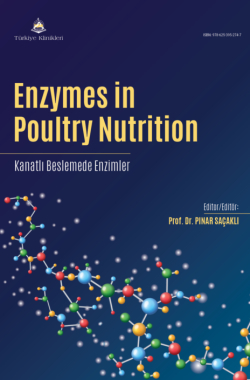Regulations on Feed Enzymes
Gülcan DEMİRELa
aİstanbul University-Cerrahpaşa Faculty of Veterinary Medicine, Department of Animal Nutrition and Nutritional Diseases, İstanbul, Türkiye
Demirel G. Regulations on feed enzymes. In: Saçaklı P, ed. Enzymes in Poultry Nutrition. 1st ed. Ankara: Türkiye Klinikleri; 2024. p.80-4.
ABSTRACT
Quantitative and qualitative improvements have been achieved in animal products with the use of enzymes obtained as a result of biotechnological studies in the field of animal nutrition after the 1950s. During all these developments, it has been observed that probiotics, enzymes, and antibiotics, along with growth promoter substances, are used more widely. The feed enzymes market has grown rapidly as a result of high raw material cost and an EU wide ban on antibiotics as growth promoters. The market is driven by the growing meat industry due to the increase in world population. In general, additives are thoroughly evaluated by authorities for effectiveness and safety before they are allowed for use worldwide. Most countries have regulations governing the marketing of feed enzymes. Feed enzyme manufacturers must provide evidence that the enzyme is safe and effective for the target species. Evidence of product quality, such as consistency and stability, must also be approved. This review is about the regulations, approval processes and differences in implementation for enzymes added to animal feed.
Keywords: Animal feed; enzymes; government regulation
Kaynak Göster
Referanslar
- Ravindran V. Feed enzymes: The science, practice, and metabolic realities. J Appl Poultry Res. 2013;22(3):628-36. [Crossref]
- Muck RE, Nadeau EMG, McAllister TA, Contreras-Govea FE, Santos MC, Kung L. Silage review: Recent advances and future uses of silage additives. J Dairy Sci. 2018;101(5):3980-4000 [Crossref] [PubMed]
- Expert Market Research (Internet). EMR Claight Corporation© 2023 (cited: Nov 5, 2023). Available from: [Link]
- Kocabas DS, Grumet R. Evolving regulatory policies regarding food enzymes produced by recombinant microorganis. GM Crops & Food. 2019;10:191-207. [Crossref] [PubMed] [PMC]
- OECD/FAO. OECD-FAO Agricultural Outlook 2021-2030. Paris: OECD Publishing; 2021.
- Nunes CS, Kunamneni A, Kumar V, Habte-Tsion HM. Registration of food and feed additives (enzymes) in the United States, Canada, and China. Enzymes in Human and Animal Nutrition. 2018;457-80. [Crossref]
- Smedley KO. Comparison of Regulatory Management of Authorized Ingredients, Approval Processes, and Risk-Assessment Procedures for Feed Ingredients. 2013; Available from: [Link]
- European Parliament and Council. Regulation (EC) No 1829/2003 of the European Parliament and of the council on genetically modified food and feed. OJEU. 2003;268:29-43.
- EFSA. Administrative guidance for the preparation of applications on additives for use in animal nutrition. EFSA support. Publ. 2021;6508. p. 40.
- Canadian Food Inspection Agency (Internet). Goverment of Canada, © 2023 (cited: 20 June 2023). Available from: [Link]
- European Parliament and Council. Regulation (EC) No 429/2008 of the European Parliament and of the Council of 25 April 2008 on detailed rules for the implementation of Regulation (EC) No 1831/2003 of the European Parliament and of the Council as regards the preparation and the presentation of applications and the assessment and the authorisation of feed additives. OJEU. 2008;133:1-63.
- Spok A. Safety Regulations of Food Enzymes, Food Technol. Biotechnol. 2006;44(2)197-209.
- EFSA. FEEDAP Panel (EFSA Panel on additives and products or substances used in animal feed), Guidance on the assessment of the safety of feed additives for the target species. EFSA Journal. 2017;15(10):5021-40.
- Deckers M, Deforce D, Fraiture MA, Roosens NHC. Genetically Modified Micro-Organisms for Industrial Food Enzyme Production: An Overview. Foods. 2020;9(3):326-46. [Crossref] [PubMed] [PMC]
- European Parliament and Council. Council Directive (EU) 70/524/EEC of 23 November 1970 concerning additives in feeding-stuffs. OJEU. 270;1-87.

